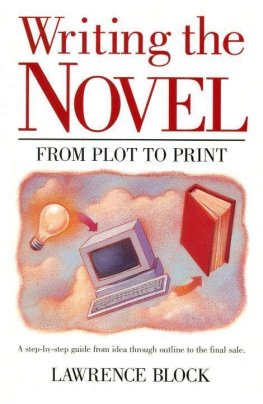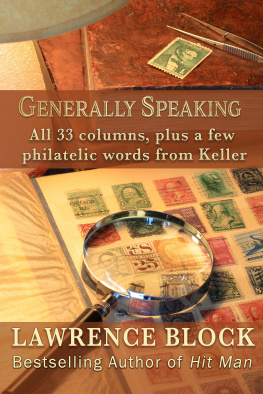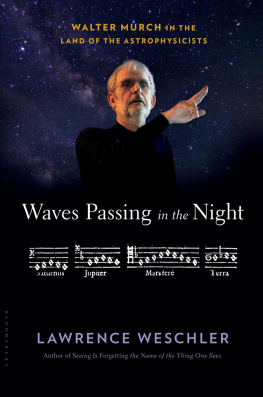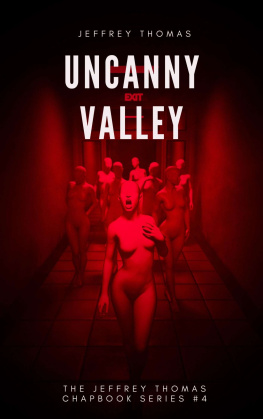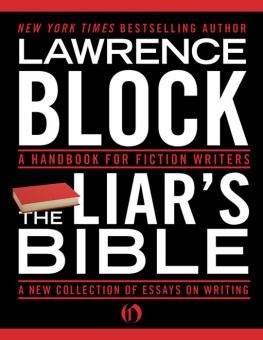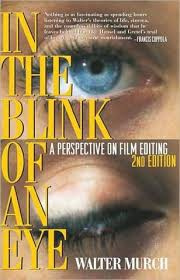Table of Contents
Guide
Table of Contents
Also by Lawrence Weschler
Political Reportage
The Passion of Poland
A Miracle, A Universe: Settling Accounts with Torturers
Calamities of Exile: Three Nonfiction Novellas
Passions and Wonders
Seeing is Forgetting the Name of the Thing One Sees: Thirty Years of Conversations with the Artist Robert Irwin
Shapinskys Karma, Boggss Bills and Other True-Life Tales
Mr Wilsons Cabinet of Wonder
A Wanderer in the Perfect City: Selected Passion Pieces
Boggs: A Comedy of Values
Robert Irwin Getty Garden
Vermeer in Bosnia: A Reader
Everything that Rises: A Book of Convergences
True to Life: Twenty-five Years of Conversations with the Artist David Hockney
Recent Art Monographs
Deborah Butterfield
Tara Donovan
Liza Lou
The Richard and Mary Gray Collection: Seven Centuries of Art
Mark Dion: The Marvelous Museum
The Art Guys: Forever Yours
Michael Light: L.A. Day/L.A. Night
FOR OLIVER
and in memory of
TOM EISNER
(1929-2011)
Living wonders
Brimming friends
Uncanny Valley:
ON THE DIGITAL ANIMATION OF THE FACE (2002)
Faces hit walls all the time in the movies, but this was different:
The Wall these filmmakers kept running up against, or so I was being told, was the Face itself. Digital animators, that is, in their quest to perfect ever more believable computerized simulations of a human being, a credible cyberactor moving through time and space. Bodieswalking, standing, running, slouching, brawlingturns out, I was being assured, that these are all quite doable, no longer that big a deal. Handsgrasping, signaling, stroking, idling at restgranted, theyre a bit more of a challenge, but not all that much more, and at least conceptually within reach. But a believable human facea credible face in motion, and whats more, emotingdamn, but that was proving tough. A hard nut. A daunting massif. And some were beginning to ask themselves whether this particular Wall was even theoretically scalable.
Which didnt seem all that surprising to me (and let me admit right here at the outset that Im a rank outsider; I dont even know how I got called onto this story). Naturally, I surmised, they cant do faces because, as everybody knows, faces (as opposed, say, to arms, or thighs, or abdomens) are the Seat of the Soul, and souls simply arent quantifiable; they dont resolve themselves into so many bitsno matter how many.
On the flight out to San Francisco, in whose environs I was going to be spending the next few days ambling among the cyberscenti, taking the Massifs measure, as it were, I once again recalled the formulations of one of my favorite touchstone philosophers, the late-medieval number-mystic Nicholas of Cusa (140164). Faced with the claims of the ever more positivist Scholastics of his own time, Cusa likened true knowledge of God and the Infinite to a circle, within which was slotted a regular compounding n-sided polygon: a triangle, say, and then a square, a pentagon, a hexagon, and so forth. Keep adding sidesa hundred, a thousand, a millionand true, Nicolas conceded, it seems like youd be getting closer and closer to the encompassing circle. But in fact, he went on to point out, youd be getting further and further away, because a million-sided polygon, for example, has precisely that: a million angles, a million sides. Whereas a circle has no angles and only one side. And, bracketing the God question (for a moment, anyway), it seemed to me that the Face-stalkers had set themselves a similarly impossible challenge, because a million-bitted face, no matter how seemingly close, was destined to fall infinitely (albeit infinitesimally) short of the simple, seamless whole that is any actual face (and any actually human way of perceiving that face).
TELL YOU ONE THING, though: Those guys (and most of them, incidentally, are guys) sure are having themselves a helluva good time.
Take Henrik Wann Jensen, for example, over at Stanfordmy first stop. Guy spends his days and late nights thinking about milk. Dinosaurs are easy, he assures me; milk is hard.
A research associate in the Computer Graphics Lab in the universitys (figures) William Gates Hall (to which he is late for our appointment because, as he explains, there was a mysterious power outage at his apartment complex, which prevented him from getting his car past the electronically controlled gates of his garage, so that hed had to bike over insteadall of which seems oddly freighted with metaphorical significance of some sort), the young Dane focuses his interest on translucency, luminosity, the soft sheen of the real: milk, marble, human skin. To glow or not to glow: That is the challenge.
Light hits a surface and bounces off, Jensen explains to me, himself vaulting over to his blackboard to sketch out a billiardlike bankshot, and if the surface is sufficiently opaque and reflectivemetal, say, or plastic, or an antlike exoskeletonthe formulae and algorithms are all pretty straightforward and they dont require all that much computer power to flesh out. Which is one reason the early breakthroughs in realistic computer animation involved plastic toys or shiny insects (or leathery dinosaurs). But photons of light behave differently upon contact with flesh and marbleand milk: They dont just ricochet off the surface; they penetrate, scattering about inside there in confounding quantum fashion and then emerging at entirely different places and at altogether different angles than the standard Newtonian billiard model might have predicted. Use the standard formulae, and skin will end up looking like plastic, marble like concrete, and a glass of milk like a column of chalk.
Jensen boots up his computer and powers up a set of exemplary illustrations, his lifes work. For instance, he says, this is a glass of digital milk, illuminated by an orbiting light source, using the standard Newtonian algorithmsand indeed, the stuff looks distinctly unpalatable: not even liquid. But instead if you use the photon-mapping technique weve been developing, granted it will take your computer a whole lot more time to churn out the calculations, but youll end up with something more like this. Like something straight out of an ad, that is. Got Milk, indeed.
Note the meniscus. Jensen, the proud father, points to the infinitesimal upslope along the milk surfaces rim as it meets the circumference of the glass, an effect of surface tension. Most modelers forget about the meniscus, and as a result, something just doesnt look right. This, I will find, is a typical sort of comment among the cyberscentimarvel both at the tiniest of details and at the human capacity (nay, propensity!) for noticing those tiniest of details.
The meniscus, naturally, turns out to have all sorts of light-scattering characteristics distinct from the rest of the milk, and all of that needs to be taken into accountcounted and gauged and painstakingly crunched. And milk matters, not simply as an exercise. It turns out, according to Jensen, that skim milk evinces exactly the same light-scattering characteristics and color (a slight bluish-gray) as the whites of a persons eyes.



